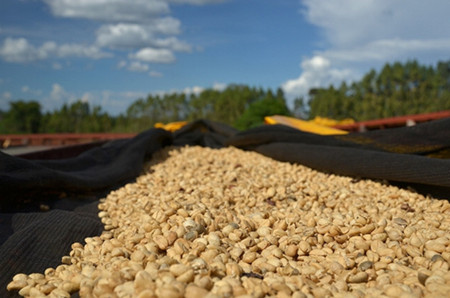El Salvador Himalayan Coffee Manor introduces quality Salvadoran coffee beans red bourbon boutique
Located in Santa Ana, a famous producing area in the Apaneca Mountains at an altitude of 1500 meters, Himalayan Manor is one of the few estates managed by Aida Batlle. The main varieties planted are bourbon.

The coffee beans from the estate are washed at Mauricio Salaverria's El Divisadero processing plant in Ataco, and then evenly dried in an African elevated shed bed with the help of sun and ventilation. Following the career of his parents and grandparents, Mauricio has been associated with coffee since childhood, especially focusing on the cultivation of boutique coffee.
Flavor description: red wine, sour plum, brown sugar, full taste and long finish
About Project Origin
The winner of the Sasa Sestic,2015 World Barista Competition and his business team ONA Coffee started a raw bean shopping program called Project Origin three years ago. The project works directly with coffee growers in poor countries and regions to improve their production conditions and give them a purchase price 20% higher than the fair trade price.
The original intention of the project also includes strengthening the links between roasters and coffee farmers and guiding coffee farmers to grow high-quality coffee beans. So far, Sasa has established relationships with coffee growers from eight countries, including Brazil, Panama, India, Ethiopia, El Salvador and Costa Rica.
Half-sun method: because the early Brazilian coffee is all treated by traditional sun treatment, the overall quality of Brazilian coffee is unstable and can only wander in the middle and lower grade. In order to improve the quality of coffee in Brazil, the Brazilian government has invented half-sun method and vigorously promoted it. At present, almost all high-quality coffee beans in Brazil use half-sun method to treat raw beans. It can be said that half-sun method has successfully improved the overall quality of Brazilian coffee. The pre-treatment method of the half-sun method is almost the same as the water washing method, first put the coffee fruit into a large water tank, remove the floating fruit, and then put the sunken fruit into the pulp sieving machine to remove the pulp. Through the above steps, not only the immature fruit can be better removed, but more importantly, when the coffee beans are dried in the sun, they are no longer with pulp, but only wrapped in a layer of pectin, which is more helpful to control the subsequent fermentation process. After removing the pulp, the fermentation process is somewhat similar to the drying method. The beans are moved to the bean drying farm to dry, which can reach a certain degree of drying in about 3 days, and then further dried with a dryer until the water content of the beans reaches 10.5% to 12%. The final polishing process will be carried out before the beans are bagged and exported. Because the half-sun method has certain requirements for climate and technology, it can only be widely used in Brazil. Through half-sun treatment, it not only retains the unique sweet taste of the sun method, but also avoids the mildew taste of the sun method, shaping the unique flavor of Brazilian coffee.
Important Notice :
前街咖啡 FrontStreet Coffee has moved to new addredd:
FrontStreet Coffee Address: 315,Donghua East Road,GuangZhou
Tel:020 38364473
- Prev

Introduction of Nicaraguan Fine Coffee beans Nicaraguan Coffee Flavor characteristics Nicaraguan Coffee taste
In many countries, coffee production has been seriously affected for political reasons. Nicaraguan coffee industry is no exception. The 1979 revolution forced coffee planters to flee to Miami. A period of indecision followed, when the government considered whether to redistribute land, including many plantations, which led to a shortage of coffee and a decline in production. Niagara
- Next

The origin of Guatemalan boutique coffee introduces the unique quality of Guatemalan coffee
Guatemala Antigua Coffee is not only smooth, high hardness, good quality, more full-bodied and sour and sweet perfect match, coupled with a trace of smoke, but also emphasizes its deep and mysterious. Guatemala is located in the center of North and South America, and its geographical location occupies an important position in Central America. Guatemala covers an area of about 108899 square kilometers. The territorial characteristics can be divided into: plateau volcanoes,
Related
- Does Rose Summer choose Blue, Green or Red? Detailed explanation of Rose Summer Coffee plots and Classification in Panamanian Jade Manor
- What is the difference between the origin, producing area, processing plant, cooperative and manor of coffee beans?
- How fine does the espresso powder fit? how to grind the espresso?
- Sca coffee roasting degree color card coffee roasting degree 8 roasting color values what do you mean?
- The practice of lattes: how to make lattes at home
- Introduction to Indonesian Fine Coffee beans-- Java Coffee producing area of Indonesian Arabica Coffee
- How much will the flavor of light and medium roasted rose summer be expressed? What baking level is rose summer suitable for?
- Introduction to the characteristics of washing, sun-drying or wet-planing coffee commonly used in Mantenin, Indonesia
- Price characteristics of Arabica Coffee Bean Starbucks introduction to Manning Coffee Bean Taste producing area Variety Manor
- What is the authentic Yega flavor? What are the flavor characteristics of the really excellent Yejasuffi coffee beans?

